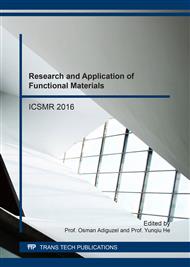p.61
p.65
p.69
p.74
p.78
p.83
p.89
p.93
p.101
The Study of Ion Beam Assisted Deposition of CuInSe2 Absorber Films
Abstract:
Based on the selenium ion beam assisted magnetron sequential sputtering technology, low temperature deposition of CIS thin-film solar cells in high quality can be achieved. By comparing with the method of conventional gas phase atomic deposition, and through simulated analysis from the perspective of diffusion uniformity, numerical calculation on the depth of ion beam injection is proceeded. First, according to the classical collision theory in molecular dynamics, the theoretical calculation on the process of ion implantation is done; the concentration distribution of implanted selenium ions can be got by using TRIM program for simulation analysis. On this basis, the concentration distribution of selenium ion after diffusion can be further obtained. Finally, the calculation model is established; through comparison and analysis, when the selenium diffusion uniformity is same in the both conditions, the substrate temperature T1 needed for ion beam assisted deposition and the substrate temperature T2 needed for gas phase atomic deposition are respectively calculated. The calculation results show that on the premise of merely considering the depth of implanted ions, from the perspective of the diffusion uniformity, the selenium ion beam assisted deposition technique can obviously reduce the substrate temperature comparing with traditional vapor deposition technology.
Info:
Periodical:
Pages:
78-82
Citation:
Online since:
July 2017
Authors:
Price:
Сopyright:
© 2017 Trans Tech Publications Ltd. All Rights Reserved
Share:
Citation:


